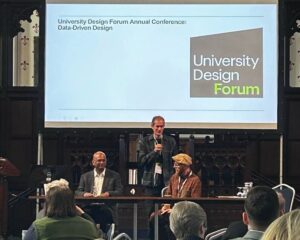Article
A wonderful bunch of places
4:46:40 3 July 2024
55°51′40″N 04°15′00″W
The late great Dutch architect Aldo van Eyck famously declared that ‘whatever space and time mean, place and occasion mean more’. He goes on to say: ‘Place and occasion imply participation in what exists, lack of place – and thus of occasion – will cause loss of identity, isolation and frustration. A house, therefore, should be a bunch of places, and the same applies no less to a city.’
And no less to the post-Covid university campus, which is experiencing an engagement crisis, the result, as van Eyck might say, of it having (at least partially) ceased in the minds of its participants as being the place and occasion for life at university. Certainly, this loss of ‘campus as place’ was a key sub-theme at the University Design Forum’s annual conference, which this year explored the influence of AI, data, and technology on university design, and which I had the good fortune to both attend and speak at.

In the heady perma-glow of the extraordinary advances in and promises of articial intelligence, there is a sense that data design is something special when it comes to reclaiming the campus as a place of active, social, and collaborative learning. An empirical understanding of the problem of engagement means an empirical understanding of the solution to the crisis and therefore to increasing levels of performance and satisfaction as it is iteratively resolved. With inputs and outputs based on an astonishingly large and continually well analysed evidence-base, the final desired outcome should be more easily determined and so more attainable.
While I didn’t have the time to dip into everything on offer at the conference, it was clear from what I did see and hear that there is great deal of good data-related work going on. I shared, for example, the stage with Perkins & Will’s Gautam Sundaram, and very much enjoyed how his work helps define those abovementioned outputs, bringing them together with a very clear model for analysing and reporting on them. I also met a number of people who were speaking quite brilliantly about how they were managing the outputs of design, delivery and operations, their engineering solutions something else.
However, it’s clear that we are all struggling with the sheer weight of the data gathered, the task of analysing it, of working out what super-informed opportunity – energy, behaviour, asset function, programming – to prioritise, and then managing to persuade cash-strapped and / or risk adverse universities as to the veracity of data-driven strategies. By chance, this all played well to my own contribution to the debate, which centred on the importance of leading any and all interventions with a narrative-driven vision, one that drives strategy, briefs design, underwrites delivery, and guides how they take shape and continually improve.
If I was slightly nervous as to how this might land, I needn’t have worried. Hanging the argument on our passenger-first whole-ecosystem work with Melbourne Airport or on the attention paid to touchpoints and the use of pilots as a means of testing, measuring, and improving by Nike didn’t phase the audience. On the contrary, there was a real feel in the room and in discussions I’ve had since for how data design and the narrative-driven vision complement each other beautifully. Together, they have the capacity to turn the engagement crises on its head, and so help return the campus to what it ought to be: a truly wonderful bunch of places.
Adam Scott attended the University Design Forum’s Annual Conference 2024: Data-driven Design at the University of Glasgow, early last month. The University Design Forum is an independent organisation founded to promote high quality design in University campuses, buildings and facilities, in the knowledge that this enhances teaching, learning, research and public engagement.
Image credit: Vishnu Prasad



